|
Forging the Pharaoh's Name
Forgery as a means to fame and fortune is not uncommon in commerce
and
the arts, in science and antiquities. When exposed, it may cause
loss and
shame. When sustained, it may change the records of history.
This, we believe, has happened to the Great Pyramid and its presumed
builder, the Pharaoh named Khufu.
Systematic and disciplined archaeological re-examination of pyramid
sites
that were hurriedly excavated a century and a half ago (many times
by
treasure hunters), has raised numerous questions regarding some of
the
earlier conclusions. It has been held that the Pyramid Age began
with
Zoser's step pyramid, and was marked by successive progression
toward a
true pyramid, which finally succeeded. But why was it so important
to
achieve a true pyramid? If the art of pyramid building was
progressively
improved, why were the many pyramids which followed the Giza
pyramids
inferior, rather than superior to those of Giza?
Was Zoser's step pyramid the model for others, or was it itself an
emulation of an earlier model? Scholars now believe that the first,
smaller
step pyramid (Fig. 125) that Imhotep built over the mastaba "was
cased
with beautiful, fine white limestone" (Ahmed Fakhry, The Pyramids);
"before this casing was complete, however, he planned another alteration"—the superimposition of an even larger pyramid. However, as new
evidence suggests, even that final step pyramid was cased, to look
like a
true pyramid.
The casing, uncovered by archaeological missions of
Harvard
University led by George Reisner, was primitively made of mud
bricks,
which of course crumbled soon enough—leaving the impression that
Zoser
built a step pyramid. Moreover, these mud bricks, it was found, were
whitewashed to simulate a casing of white limestone.
Whom then was Zoser trying to emulate? Where had Imhotep seen a
true pyramid already up and complete, smooth sides and limestone
casing
and all? And another question: If, as the present theory holds, the
attempts
at Maidum and Sakkara to build a smooth, 52° pyramid had failed, and
Sneferu had to "cheat" and build the presumed first true pyramid at
an
angle of only 43°—why did his son at once proceed to build a much
larger pyramid at the precarious angle of 52°—and supposedly managed
to achieve that with no problem at all?
If the pyramids of Giza were only "usual" pyramids in the successive
chain of pyramid-per-Pharaoh—why did Khufu's son Radedef not build
his pyramid next to his father's, at Giza? Remember—the other two
Giza pyramids were supposedly not there yet, so Radedef had the
whole site free to build as he pleased. And if his father's
architects and engineers mastered the art of building the Great
Pyramid, where were they to help Radedef build a similar imposing
pyramid, rather than the inferior and quickly crumbling one that
bears his name?
Was the reason that no other pyramid but the Great Pyramid possessed
an Ascending Passage, that its unique Ascending Passage was
successfully blocked and hidden until AD. 820—so that all who
emulated this pyramid knew of a Descending Passage only?
The absence of hieroglyphic inscriptions in the three pyramids of
Giza is also a reason for wondering, as James Bonwick did a century
ago (Pyramid Facts and Fancies):
"Who can persuade himself that the
Egyptians would have left such superb monuments without at least hieroglyphical inscriptions—they who were profuse of hieroglyphics
upon all the edifices of any consideration?"
The absence, one must
surmise, stems from the fact that the pyramids had either been built
before the development of hieroglyphic writing, or were not built by
the Egyptians.
These are some of the points that strengthen our belief that when
Zoser and his successors began the custom of pyramid building, they
set out to emulate the models that had already existed: the pyramids
of Giza. They were not improvements on Zoser's earlier efforts;
rather, they were the prototypes which Zoser, and Pharaohs after
him, attempted to emulate.
Some scholars have suggested that the small satellite pyramids at
Giza were really scale models (about 1:5) that were used by the
ancients exactly as today's architects use scale models for
evaluation and guidance; but it is now known that they were later
augmentations. However, we think that there was indeed such a scale
model; the Third Pyramid, with its obvious structural experiments.
Then, we believe, the larger two were built as a pair of guiding
beacons for the Anunnaki.
But what about Menkara, Chefra and Khufu, who (we have been told by
Herodotus) were the builders of these pyramids?
Well indeed—what about them? The temples and causeway attached to
the Third Pyramid do bear evidence that their builder was Menkara—
evidence that includes inscriptions bearing his name and several
exquisite statues showing him embraced by Hathor and another
Goddess. But all that this attests to is that Menkara built these
auxiliary structures, associating himself with the pyramid—not that
he built it.
The Anunnaki, it is logical to assume, needed only the
pyramids and would not have built temples to worship themselves;
only a Pharaoh required a funerary temple and a mortuary temple and
the other structures associated with his journey to the Gods.
Inside the Third Pyramid proper, not an inscription, not a statue,
not a decorated wall have been found; just stark, austere precision.
The only purported evidence proved to be a false pretense: the
fragments of the wooden coffin inscribed with the name of Menkara
proved to be from a time some 2,000 years after his reign; and the
mummy "matching" the coffin was from early Christian times. There is
thus not a shred of evidence to support the notion that Menkara—or
any Pharaoh for that matter—had anything to do with creating and
building the pyramid itself.
The Second Pyramid is likewise completely bare. Statues bearing the
cartouche (oval frame within which the royal name is inscribed) of
Chefra were found only in the temples adjoining the pyramid. But
there is nothing at all to indicate that he had built it.
What then, about Khufu?
With one exception, which we will expose as a probable forgery, the
only claim that he built the Great Pyramid is reported by Herodotus
(and, based on his writings, by a Roman historian). Herodotus
described him as a ruler who enslaved his people for thirty years to
build the causeway and the pyramid. Yet by every other account,
Khufu reigned for only twenty-three years. If he were such a
grandiose builder, blessed with the greatest of architects and
masons, where are his other monuments, where are his
bigger-than-life statues?
There are none; and it would seem from the absence of such
commemorative remains that Khufu was a very poor builder, not a
majestic one. But he had a bright idea: our guess is that having
seen the crumbled mud-brick casings of the step pyramids, the
collapsed pyramid at Maidum, the hurried bending of the first
pyramid of Sneferu, the improper inclination of Sneferu's second
pyramid—Khufu hit upon a great idea.
Out there, at Giza, there stood
perfect and unspoken of pyramids. Could he not ask the Gods'
permission to attach to one of them the funerary temples which his
Journey to the Afterlife required? There was no intrusion upon the
sanctity of the pyramid itself: all the temples, including the
Valley Temple in which Khufu was probably buried, were on the
outside: adjoining, but not even touching, the Great Pyramid. Thus
had the Great Pyramid become known as Khufu's.
Khufu's successor, Radedef, shunned his father's idea and preferred
to raise his own pyramid, as Sneferu had done. But why had he gone
to the north of Giza, rather than place his shrine next to his
father's? The simple explanation is that the promontory of Giza was
already fully occupied—by three olden pyramids plus the satellite
structures erected nearby by Khufu... .
Witnessing Radedef's failure, the next Pharaoh—Chefra—preferred
Khufu's solution. When his time came to need a pyramid, he saw no
harm in appropriating for himself the ready-made second large
pyramid, sur-rounding it with his own temples and satellites.
Menkara, his successor, then attached himself to the last available
pyramid, the so-called Third Pyramid.
With the ready-made pyramids thus taken, the Pharaohs who followed
were forced to obtain pyramids the hard way: by trying to build
them... . As those who had tried this before (Zoser, Sneferu,
Radedef), their own efforts too ended with inferior emulations of
the three olden pyramids.
At first blush, our suggestion that Khufu (as the other two) had
nothing to do with building the pyramid associated with him may
sound very farfetched. It is hardly so. In evidence, we call upon
Khufu himself.
Whether Khufu had really built the Great Pyramid was a question that
began to perplex serious Egyptologists more than a century and a
quarter ago, when the only object mentioning Khufu and connecting
him with the pyramid was discovered. Puzzlingly, it affirmed that he
did not build it: it already existed when he reigned!
The damning evidence is a limestone stela (Fig. 141) which was
discovered by Auguste Mariette in the 1850s in the ruins of the
temple of Isis, near the Great Pyramid. Its inscription identifies
it as a self-laudatory monument by Khufu, erected to commemorate the
restoration by him of the temple of Isis and of images and emblems
of the Gods which Khufu found inside the crumbling temple.
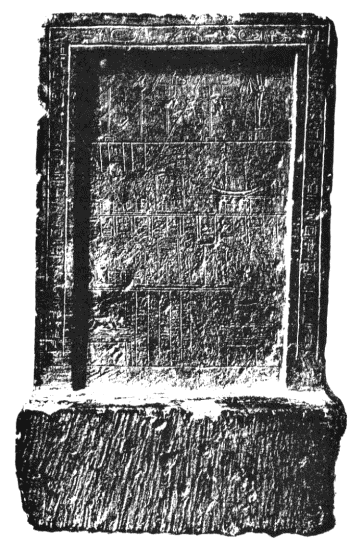
Fig. 141
The
opening verses unmistakably identify Khufu by his cartouche:

The common opening, invoking Horus and proclaiming long life for the
king, then packs explosive statements:
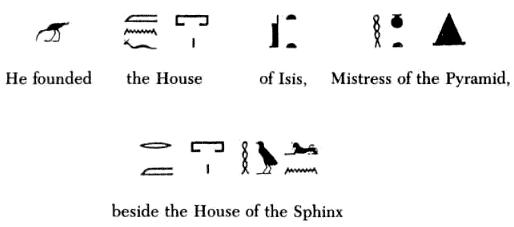
According to the inscription on this stela (which is in the Cairo
Museum), the Great Pyramid was already standing when Khufu arrived
on the scene.
Its mistress was the Goddess Isis—it belonged to this Goddess, and
not to Khufu. Furthermore, the Sphinx too—which has been attributed
to Chefra, who presumably built it together with the Second
Pyramid—was also already crouching at its present location. The
continuation of the inscription pinpoints the position of the Sphinx
accurately, and records the fact that part of it was damaged by
lightning—a damage perceivable to this very day.
Khufu continues to state in his inscription that he built a pyramid
for the Princess Henutsen "beside the temple of the Goddess."
Archaeologists have found independent evidence that the southernmost
of the three small pyramids flanking the Great Pyramid—the small
pyramid nearest the temple of Isis—was in fact dedicated to
Henutsen, a wife of Khufu.
Everything in the inscription thus
matches the known facts; but the only pyramid-building claim made by Khufu is that he built the small pyramid for the princess. The Great
Pyramid, he states, was already there, as was the Sphinx (and, by
inference, the other two pyramids as well).
Such support for our theories is even further strengthened, as we
read in another portion of the inscription that the Great Pyramid
was also called "The Western Mountain of Hathor":
Live Horus Mezdau;
To King of Upper and Lower Egypt, Khufu,
Life is given.
For his mother Isis, the Divine Mother,
Mistress of "The Western Mountain of Hathor,"
he made (this) writing on a stela.
He gave (her) a new sacred offering.
He built (her) a House (temple) of stone,
renewed the Gods that were found in her temple.
Hathor, we will recall, was the mistress of the Sinai peninsula. If
the highest peak of the peninsula was her Eastern Mountain, the
Great Pyramid was her Western Mountain—the two acting as the anchors
for the Landing Corridor.
This "Inventory Stela," as it came to be called, bears all the marks
of authenticity. Yet scholars at the time of its discovery (and many
ever since) have been unable to reconcile themselves to its
unavoidable conclusions. Unwilling to upset the whole structure of
Pyramidology, they proclaimed the Inventory Stela a forgery—an
inscription made "long after the death of Khufu" (to quote
Selim
Hassan, Excavations at Giza), but invoking his name "to support some
fictitious claim of the local priests."
James H. Breasted, whose Ancient Records of Egypt is the standard
work on ancient Egyptian inscriptions, wrote in 1906 that,
"the
references to the Sphinx, and the so-called temple beside it in the
time of Khufu, have made this monument from the first an object of
great interest. These references would be of the highest importance
if the monument were contemporaneous with Khufu; but the orthographic evidences of its late date
are entirely conclusive."
He disagreed with Gaston Maspero, a
leading Egyptologist of the time, who had earlier suggested that the
stela, if indeed of late orthography, was a copy of an earlier and
authentic original. In spite of the doubts, Breasted included the
inscription among the records of the Fourth Dynasty. And Maspero,
when he wrote his comprehensive The Dawn of Civilization in 1920,
accepted the contents of the Inventory Stela as factual data
concerning the life and activities of Khufu.
Why then the reluctance to call the artifact authentic?
The Inventory Stela was condemned as a forgery because only a decade
or so earlier the identification of Khufu as the builder of the
Great Pyramid appeared to have been undisputably established. The
seemingly conclusive evidence was markings in red paint, discovered
in sealed chambers above the King's Chamber, which could be
interpreted as masons' markings made in the eighteenth year of the
reign of Khufu (Fig. 142).
Since the chambers were not entered until
discovered in 1837, the markings must have been authentic; and if
the Inventory Stela offered contradictory information, the Stela
must have been a forgery.

Fig. 142
But as we probe the circumstances of the red-paint markings, and
ascertain who the discoverers were—an inquiry somehow never
under-taken before—the conclusion that emerges is this: if a forgery
had taken place, it occurred not in ancient times but in the year
A.D. 1837; and the forgers were not "some local priests," but two
(or three) unscrupulous Englishmen... .
The story begins with the arrival in Egypt on December 29, 1835 of
Colonel Richard Howard Vyse, a "black sheep" of an aristocratic
English family. At that time, other officers of Her Majesty's Army
had become prominent in the ranks of "antiquarians" (as
archaeologists were then called), reading papers before
distinguished societies and receiving due public accolade.
Whether
or not Vyse had gone to Egypt with such notions in mind, the fact is
that visiting the pyramids of Giza, he was at once caught by the
fever of daily discoveries by scholars and laymen alike. He was
especially thrilled by the tales and theories of one Giovanni
Battista Caviglia, who had been searching for a hidden chamber
inside the Great Pyramid.
Within days, Vyse offered to provide the funds for Caviglia's
search, if he were accepted as a co-discoverer. Caviglia rejected
the offer outright; and the offended Vyse sailed off to Beirut at
the end of February 1836, to visit Syria and Asia Minor.
But the long trip did not cure the craving that was aroused within
him. Instead of returning to England, he showed up back in Egypt in
October 1836. On the earlier visit, he had befriended a crafty
go-between by the name of J. R. Hill, then a copper mill
superintendent. Now he was introduced to a "Mr. Sloane," who
whispered that there were ways to get a Firman—a concession
decree—from the Egyptian government to sole
excavation rights at Giza.
Thus guided, Vyse went to the British
Consul, Col. Campbell, for the necessary documentation. To his great
shock, the Firman named Campbell and Sloane as co-permitees, and
designated Caviglia as the works' supervisor. On November 2, 1836,
the disappointed Vyse paid over to Caviglia "my first subscription
of 200 dollars" and left in disgust on a sightseeing trip to Upper
Egypt.
As chronicled by Vyse in his Operations Carried on at the Pyramids
of Gizeh in 1837, he returned to Giza on January 24, 1837,
"extremely anxious to see what progress had been made." But instead
of searching for the hidden chamber, Caviglia and his workmen were
busy digging up mummies from tombs around the pyramids. Vyse's fury
subsided only when Caviglia asserted that he had something important
to show him: writing by the pyramids' builders!
The excavations at the tombs showed that the ancient masons
sometimes marked the pre-cut stones with red paint. Such markings,
Caviglia said, he found at the base of the Second Pyramid. But when
examined with Vyse, the "red paint" turned out to be natural
discolorations in the stone.
What about
the Great Pyramid? Caviglia, working there to discover
where the "air channels" were leading from the "King's Chamber," was
more than ever convinced that there were secret chambers higher up.
One such compartment, reachable via a crawlway, was discovered by
Nathaniel Davison in 1765 (Fig. 143).
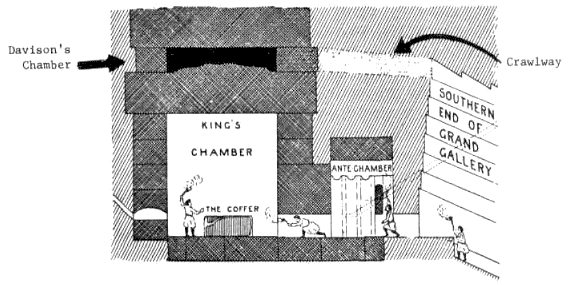
Fig. 143
Vyse demanded that work be
concentrated there; he was dismayed to find out that Caviglia and
Campbell were more interested in finding mummies, which every museum
then desired. Caviglia had even gone so far as to name a large tomb
he had found "Campbell's Tomb."
Determined to run his own show, Vyse moved from Cairo to the site of
the pyramids. "I naturally wished to make some discoveries before 1
returned to England," he admitted in his journal on January 27,
1837. At great expense to his family, he was now gone for well over
a year.
In the following weeks, the rift with Caviglia widened as Vyse
hurled at him various accusations. On February 11, the two had a
violent argument. On the twelfth, Caviglia made major discoveries in
Campbell's Tomb: a sarcophagus inscribed with hieroglyphs and
masons' red-paint markings on the stone walls of the tomb. On the
thirteenth, Vyse summarily discharged Caviglia and ordered him away
from the site. Caviglia returned only once, on the fifteenth, to
pick up his belongings; for years thereafter, he made "dishonorable
accusations" against Vyse, whose nature Vyse's chronicles do not
care to detail.
Was the row a genuine disagreement, or did Vyse artificially bring
matters to a head in order to get Caviglia off the site?
As it turned out, Vyse secretly entered the Great Pyramid on the
night of February 12, accompanied by one John Perring—an engineer
with the Egyptian Public Works Department and a dabbler in
Egyptology—whom Vyse met through the resourceful Mr. Hill. The two
examined an intriguing crevice that had developed in a granite block
above Davison's Chamber; when a reed was pushed in, it went through
unbent; there was obviously some space beyond.
What schemes did the two concoct during that secret night visit? We
can only guess from future events. The facts are that Vyse dismissed
Caviglia the next morning and put Perring on his payroll. In his
journal, Vyse confided: "I am determined to carry on the excavations
above the roof of (Davison's) Chamber, where I expect to find a
sepulchral apartment." As Vyse threw more men and money behind this
search, royalty and other dignitaries came to inspect the finds at
Campbell's Tomb; there was little new that Vyse could show them
inside the pyramid. In frustration, Vyse ordered his men to bore
into the shoulder of the Sphinx, hoping to find its masons'
markings. Unsuccessful, he refocused his attention on the Hidden
Chamber.
By mid-March, Vyse faced a new problem: other projects were luring
away his workmen. He doubled their pay, if only they would work day
and night: time, he realized, was running out. In desperation, Vyse
threw caution to the winds, and ordered the use of explosives to
blast his way through the stones that blocked his progress.
By March 27, the workmen managed to cut a small hole through the
granite slabs. Illogically, Vyse thereupon discharged the foreman,
one named Paulo. On the following day, Vyse wrote, "I inserted a
candle at the end of a rod through a small hole that had been made
in the chamber above Davison's, and I had the mortification of
finding that it was a chamber of construction like that below it."
He had found the Hidden Chamber! (Fig. 144.)
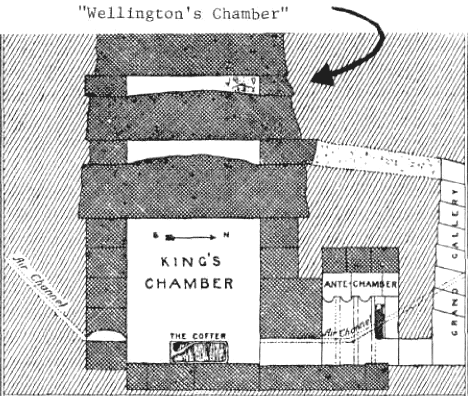
Fig. 144
Using gunpowder to enlarge the hole, Vyse entered the newly
discovered chamber on March 30—accompanied by Mr. Hill. They
examined it thoroughly. It was hermetically sealed, with no opening
whatsoever. Its floor consisted of the rough side of the large
granite slabs that formed the ceiling of Davison's Chamber below.
"A
black sediment was equally distributed all over the floor, showing
each footstep." (The nature of this black powder, which was
"accumulated to some depth," has never been ascertained.) "The
ceiling was beautifully polished and had the finest joints."
The
chamber, it was clear, had never been entered before; yet it
contained neither sarcophagus nor treasure. It was bare—completely
empty.
Vyse ordered the hole enlarged, and sent a message to the British
Consul announcing that he had named the new compartment
"Wellington's Chamber." In the evening,
"Mr. Perring and Mr. Mash
having arrived, we
went into Wellington's Chamber and took various measurements, and in
doing so we found the quarry marks."
What a sudden stroke of luck!
They were similar to the red-painted quarry marks found in tombs
outside the pyramid. Somehow, Vyse and Hill missed them entirely
when they thoroughly inspected the chamber by themselves. But joined
by Mr. Perring and by Mr. Mash—a civil engineer who was present at
Perring's invitation—there were four witnesses to the unique
discovery.
The fact that Wellington's Chamber was almost identical to Davison's
led Vyse to suspect that there was yet another chamber above it. For
no given reason Vyse dismissed on April 4 the remaining foreman, one
named Giachino. On April 14, the British Consul and the Austrian
Consul General visited the site. They requested that copies be made
of the masons' markings. Vyse put Perring and Mash to work—but
instructed them to copy first the earlier-discovered markings in
Campbell's tomb; the unique ones inside the Great Pyramid could
somehow wait.
With liberal use of gunpowder, the compartment above Wellington's
(Vyse named it after Lord Nelson) was broken into on April 25. It
was as empty as the others, its floor also covered with the
mysterious black dust. Vyse reported that he found "several quarry
marks inscribed in red upon the blocks, particularly on the west
side."
All along, Mr. Hill was going in and out of the newly found
chambers, ostensibly to inscribe in them (how?) the names of
Wellington and Nelson. On the twenty-seventh Mr. Hill—not Perring or
Mash—copied the quarry marks. Vyse reproduced the ones from Nelson's
Chamber (though not the ones from Wellington's) in his book (Fig.
145a).
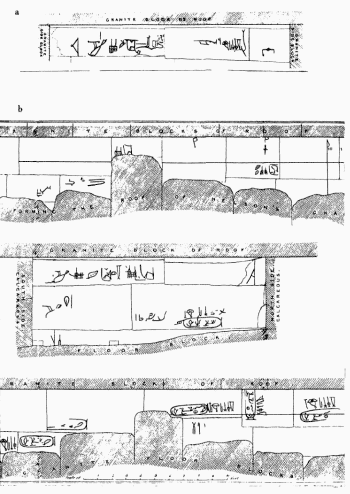
Fig. 145
On May 7, the way was blasted through into one more chamber above
Nelson's, which Vyse named temporarily after Lady Arbuthnot. The
journal entry makes no mention of any quarry marks, although they
were later on found there in profusion. What was striking about the
new markings was that they included cartouches—which could only mean
royal names (Fig. 145b)—in profusion. Has Vyse come upon the actual
written name of the Pharaoh who had built the pyramid?
On May 18, a Dr. Walni "applied for copies of the characters found
in the Great Pyramid, in order to send them to Mr. Rosellini," an
Egyptologist who had specialized in the decipherment of royal names.
Vyse turned the request down outrightly.
The next day, in the company of Lord Arbuthnot, a Mr. Brethel and a
Mr. Raven, Vyse entered Lady Arbuthnot's Chamber and the four
"compared Mr. Hill's drawings with the quarry marks in the Great
Pyramid; and we afterward signed an attestation to their accuracy."
Soon thereafter, the final vaulted chamber was broken into, and more
mark-ings—including a royal cartouche—were found. Vyse then
proceeded to Cairo and submitted the authenticated copies of the
writings on the stones to the British Embassy, for official
forwarding to London.
His work was done: he found hitherto unknown chambers, and he proved
the identity of the builder of the Great Pyramid; for within the
cartouches
was written the royal name Kh-u-f-u.

To this discovery, every textbook has been attesting to this very
day.
The impact of Vyse's discoveries was great, and their acceptance
assured, after he managed to quickly obtain a confirmation from the
experts of the British Museum in London.
When the facsimiles made by Mr. Hill reached the Museum, and when
exactly their analysis reached Vyse, is not clear; but he made the
Museum's opinion (by the hand of its hieroglyphics expert Samuel
Birch) part of his chronicle of May 27, 1837. On the face of it, the
long analysis confirmed Vyse's expectations: the names in the
cartouches could be read as Khufu or variations thereof: just as
Herodotus had written, Cheops was the builder of the Great Pyramid.
But in the excitement which understandably followed, little
attention was paid to the many if's and but's in the Museum's
opinion. It also contained the clue that tipped us off to the
forgery: the forger's clumsy mistake.
To begin with, Mr. Birch was uneasy about the orthography and script
of the many markings.
"The symbols or hieroglpyhs traced in red by
the sculptor, or mason, upon the stones in the chambers of the Great
Pyramid are apparently quarry marks," he observed in his opening
paragraph; the qualification at once followed: "Although not very
legible, owing to their having been written in semi-hieratic or
linear-hieroglyphic characters, they possess points of considerable
interest... . "
What puzzled Mr. Birch was that markings presumably from the
beginning of the Fourth Dynasty were made in a script that started
to appear only centuries later. Originating as pictographs—"written
pictures"—the writing of hieroglyphic symbols required great skill
and long training; so, in time, in commercial transactions, a more
quickly written and simpler, more linear script referred to as
hieratic came into use. The hieroglyphic symbols discovered by Vyse
thus belonged to another period.
They were also very indistinct and
Mr. Birch had great difficulty in reading them:
"The meaning of the
hieroglyphics following the prenomen in the same linear hand as the
cartouche, is not very obvious... . The symbols following the name
are very indistinct."
Many of them looked to him "written in
characters very nearly hieratic"—from an even much later period than
the semi-hieratic characters. Some of the symbols were very unusual,
never seen in any other inscription in Egypt:
"The cartouche of Suphis" (Cheops), he wrote, "is followed by a hieroglyphic to which
it would be difficult to find a parallel."
Other symbols were
"equally difficult of solution."
Mr. Birch was also puzzled by "a curious sequence of symbols" in the
upper-most, vaulted chamber (named by Vyse "Campbell's Chamber").
There, the hieroglyphic symbol for "good, gracious" was used as a
numeral—a usage never discovered before or since. Those unusually
written numerals were assumed to mean "eighteenth year" (of Khufu's
reign).
No less puzzling to him were the symbols which followed the royal
cartouche and which were "in the same linear hand as the cartouche."
He assumed that they spelled out a royal title, such as "Mighty in
Upper and Lower Egypt." The only similarity that he could find to
this row of symbols was that of "a title that appears on the coffin
of the queen of Amasis" of the Saitic period. He saw no need to
stress that the Pharaoh Amasis had reigned in the sixth century
B.C.—more than 2,000 years after Khufu!
Whoever daubed the red-paint markings reported by Vyse had thus
employed a writing method (linear), scripts (semi-hieratic and
hieratic) and titles from various periods—but none from the time of
Khufu, and all from later periods. Their writer was also not too
literate: many of his hieroglyphs were either unclear, incomplete,
out of place, erroneously employed or completely unknown.
(Analyzing these inscriptions a year later, the leading German
Egyptologist of the time, Carl Bichard Lepsius, was likewise
puzzled by the fact that the inscriptions "were traced with a brush
in red paint in a cursive manner, so much so that they resemble
hieratic signs." Some of the hieroglyphs following the cartouches,
he declared, were totally unknown, and "I am unable to explain
them.")
Turning to the main issue on which he was requested to give an
opinion—the identity of the Pharaoh named in the inscriptions—Birch
threw a bombshell: there were two, and not just one, royal names
within the pyramid!
Was it possible that two kings had built the same pyramid? And if
so, who were they?
The two royal names appearing in the inscriptions, Samuel Birch
reported, were not unknown: "they had already been found in the
tombs of functionaries employed by monarchs of that dynasty," namely
the Fourth Dynasty to whose Pharaohs the pyramids of Giza were
attributed. One cartouche (Fig. 146a) was then read Saufou or
Shoufou; the other (146b) included the ram symbol of the God
Khnum
and was then read Senekhuf or Seneshoufou.
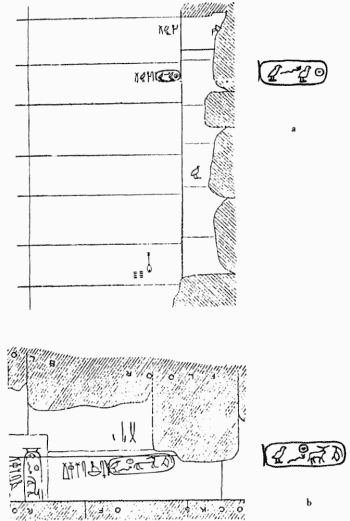
Fig. 146
Attempting to analyze the meaning of the name with the ram symbol,
Birch noted that "a cartouche, similar to that which first occurs in
Wellington's Chamber, had been published by Mr. Wilkinson, mater.
Hieroglyph, Plate of Unplaced Kings E; and also by Mr. Rosellini,
torn. i. tav.1,3, who reads the phonetic elements of which it is
composed 'Seneshufo,' which name is supposed by Mr. Wilkinson to
mean 'the Brother of Suphis.'"
That one Pharaoh might have completed a pyramid begun by his
predecessor has been a theory accepted by Egyptologists (as in the
case of the pyramid at Maidum). Could not this account for two royal
names within the same pyramid? Perhaps—but certainly not in our
case.
The impossibility in the case of the Great Pyramid stems from the
location of the various cartouches (Fig. 147). The cartouche that is
presumed to have belonged in the pyramid, that of Cheops/Khufu, was
found only in the uppermost, vaulted chamber, the one named
Campbell's Chamber. The several cartouches which spelled out the
second name (nowadays read Khnem-khuf) appeared in Wellington's
Chamber and in Lady Arbuthnot's Chamber (no cartouches were
inscribed in Nelson's Chamber).
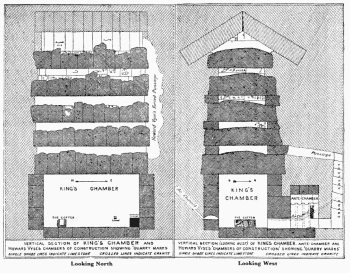
Fig. 147
In other words, the lower chambers
bore the name of a Pharaoh who lived and reigned after Cheops. As
there was no way to build the pyramid except from its base upward,
the location of the cartouches meant that Cheops, who reigned before
Chephren, completed a pyramid begun by a Pharaoh who succeeded him.
That, of course, was not possible.
Conceding that the two names could have stood for what the ancient
King Lists had called Suphis I (Cheops) and Suphis II (Chephren),
Birch tried to resolve the problem by wondering whether both names,
somehow, belonged to Cheops alone—one as his actual name, the other
as his "prenomen." But his final conclusion was that "the presence
of this (second) name, as a quarry-mark, in the Great Pyramid, is an
additional embarrass-ment" on top of the other embarrassing features
of the inscriptions.
The "Problem of the Second Name" was still unresolved when England's
most noted Egyptologist, Flinders Petrie, spent months measuring the
pyramids a half century later. "The most destructive theory about
this king (Khnem-khuf) is that he is identical with Khufu," Petrie
wrote in The Pyramids and Temples of Gizeh, giving the many reasons
voiced by then by other Egyptologists against such a theory. For any
number of reasons,
Petrie showed, the two names belonged to two separate kings. Why
then did both names appear within the Great Pyramid in the locations
in which they did? Petrie believed that the only plausible
explanation would be that Cheops and Chephren were co-regents,
reigning together.
Since no evidence to support Petrie's theory has been found, Gaston Maspero wrote almost a century after the discovery by Vyse that "the
existence of the two cartouches Khufui and Khnem-Khufui on the same
monuments has caused much embarrassment to Egyptologists" (The Dawn
of Civilization). The problem, in spite of all suggested solutions,
is still an embarrassing one.
But a solution, we believe, can be offered—if we stop attributing
the inscriptions to ancient masons, and begin to look at the facts.
The pyramids of Giza are unique, among other things, for the
complete absence of any decoration or inscription within them—with
the outstanding exception of the inscriptions found by Vyse. Why the
exception? If the masons felt no qualms about daubing in red paint
inscriptions upon the blocks of stones hidden away in the
compartments above the "King's Chamber," why were there absolutely
no such inscriptions found in the first compartment, the one
discovered by Davison in 1765—but only in the compartments found by
Vyse?
In addition to the inscriptions reported by Vyse, there have been
found in the various compartments true masons' markings—positioning
lines and arrows. They are all drawn as one would expect, with the
right side up; for when they were drawn, the compartment in which
the masons worked was not yet roofed: they could stand up, move
about and draw the markings without encumberment.
But all the
inscriptions—drawn over and around the masons' markings (Fig.
145)—are either upside down or vertical, as though whoever drew them
had to bend or crouch within the low compartments (their height
varied from one foot four inches to four feet five inches in Lady Arbuthnot's Chamber, from two feet two inches to three feet eight
inches in Wellington's Chamber).
The cartouches and royal titles daubed upon the walls of the
compartments were imprecise, crude and extra large. Most cartouches
were two and a half to three feet long and about a foot wide,
sometimes occupying the better part of the face of the stone block
on which they were painted—as though the inscriber had needed all
the space he could get. They are in sharp contrast to the precision
and delicacy and perfect sense of proportion of ancient Egyptian
hieroglyphics, evident in the true masons' markings found in those
same compartments.
With the exception of a few markings on a corner of the eastern wall
in Wellington's Chamber, no inscriptions were found on the eastern
walls of any other chamber; nor were there any other symbols (other
than the original masons' markings) found on any of these other
eastern walls, except for a few meaningless lines and a partial
outline of a bird on the vaulted eastern end of Campbell's Chamber.
This is odd, especially if one realizes that it was from the eastern
side that Vyse had tunneled to and broken into these compartments.
Did the ancient masons anticipate that Vyse would break in through
the eastern walls, and obliged by not putting inscriptions on them?
Or does the absence of such inscriptions suggest that whoever daubed
them preferred to write on the intact walls to the north, south and
west, rather than on the damaged east walls?
In other words: cannot all the puzzles be solved, if we assume that
the inscriptions were not made in antiquity, when the pyramid was
being built, but only after Vyse had blasted his way into the
compartments?
The atmosphere that surrounded Vyse's operations in those hectic
days is well described by the Colonel himself. Major discoveries
were being made all around the pyramids, but not within them.
Campbell's Tomb, discovered by the detested Caviglia, was yielding
not only artifacts but also masons' markings and hieroglyphics in
red paint. Vyse was becoming desperate to achieve his own discovery.
Finally he broke through to hitherto unknown chambers; but they only
duplicated one after the other a previously discovered chamber
(Davison's) and were bare and empty. What could he show for all the
effort and expenditure? For what would he be honored, by what would
he be remembered?
We know from Vyse's chronicles that, by day, he had sent in Mr. Hill
to inscribe the chambers with the names of the Duke of Wellington
and Admiral Nelson, heroes of the victories over Napoleon. By night,
we suspect, Mr. Hill also entered the chambers—to "christen" the
pyramid with the cartouches of its presumed ancient builder.
"The two royal names," Birch pointed out in his Opinion, "had
already been found in the tombs of functionaries employed by the
monarchs of that dynasty under which these Pyramids were erected."
The Pharaoh's artisans surely knew the correct name of their king.
But in the 1830s Egyptology was still in its infancy; and no one
could yet tell for sure which was the correct hieroglyphic design of
the king whom Herodotus called "Cheops."
And so it was, we suspect, that Mr. Hill—probably alone, certainly
at night when all others were gone—had entered the newly discovered
chambers. Using the imperative red paint, by torchlight, crouching
and bending in the low compartments, he strained to copy
hieroglyphic symbols from some source; and he drew on the walls that
were intact what seemed to him appropriate markings. He ended up
inscribing, in Wellington's Chamber as in Lady Arbuthnot's, the
wrong name.
With inscriptions of royal names of the Fourth Dynasty popping up in
the tombs surrounding the pyramids of Giza, which were the right
cartouches to be inscribed by Hill? Unschooled in hieroglyphic
writing, he must have taken with him into the pyramid some source
book from which to copy the intricate symbols. The one and only book
repeatedly mentioned in Vyse's chronicles is (Sir) John Gardner
Wilkinson's Materia Hieroglyphica. As its title page declared, it
aimed to update the reader on "the Egyptian
Pantheon and the Succession of the Pharaohs from the earliest times
to the conquest of Alexander." Published in 1828—nine years before
Vyse's assault on the pyramids—it was a standard book for English
Egyptologists.
Birch had stated in his report, "a cartouche, similar to that which
first occurs in Wellington's Chamber, had been published by Mr.
Wilkinson Mater. Hieroglyph." We thus have a clear indication of the
probable source of the cartouche inscribed by Hill in the very first
chamber (Wellington's) found by Vyse (Fig. 146b).
Having looked up Wilkinson's Materia Hieroglyphica, we can
sympathize with Vyse and Hill: its text and presentation are
disorganized, and its plates reproducing cartouches are small,
ill-copied and badly printed. Wilkinson appears to have been
uncertain not only regarding the reading of royal names, but also
regarding the correct manner by which hieroglyphs carved or sculpted
on stone should be transcribed in linear writing. The problem was
most acute concerning the disk sign, which on such monuments
appeared as either a solid disk
 or as a void sphere
or as a void sphere
 , and in linear
(or brushed-on) writing as a circle with a dot in its center , and in linear
(or brushed-on) writing as a circle with a dot in its center
 . .
In his
works, he transcribed the royal cartouches in question in some
instances as a solid disk, and in others as a circle with a dot in
its center.
Hill had followed Wilkinson's guidance. But all of these cartouches
were of the Khnum variety. Timewise, it means that by May 7 only the
"ram" cartouches were inscribed. Then on May 27, when Campbell's
Chamber was broken into, the vital and conclusive cartouche spelling
Kh-u-f-u was found. How did the miracle happen?
A clue is hidden in a suspicious segment in Vyse's chronicles, in an
entry devoted to the fact that the casing stones "did not show the
slightest trace of inscription or of sculpture, nor, indeed, was any
to be found upon any stone belonging to the pyramid, or near it
(with the exception of the quarry-marks already described)." Vyse
noted that there was one other exception: "part of a cartouche of
Suphis, engraved on a brown stone, six inches long by four broad.
This fragment was dug out of the mound at the northern side on June
2." Vyse reproduced a sketch of the fragment (Fig. 148a).
How did Vyse know—even before the communication from the British
Museum—that this was "part of a cartouche of Suphis?" Vyse would
like us to believe it was because a week earlier (on May 27) he had
found the complete cartouche (Fig. 148b) in Campbell's Chamber.

Fig. 148
But here is the suspicious aspect. Vyse claims in the above-quoted
entry that the stone with the partial Khufu cartouche was found on
June 2. Yet his entry is dated May 9! Vyse's manipulation of dates
would have us believe that the partial cartouche found outside the
pyramid corroborated the earlier find of the complete cartouche
inside the pyramid.
But the dates suggest that it was the other way
around: Vyse had already realized on May 9—a full eighteen days
before the discovery of Campbell's Chamber—
what the crucial cartouche had to look like. Somehow, on May 9, Vyse
and Hill had realized that they had missed out on the correct name
of Cheops.
This realization could explain the frantic, daily commuting by Vyse
and Hill to Cairo right after the discovery of Lady Arbuthnot's
Chamber. Why they had left when so badly needed at the pyramids, the
Chronicles do not state. We believe that the "bombshell" that hit
them was yet another, new work by Wilkinson, the three-volume
Manners and Customs of the Ancient Egyptians.
Published in London
earlier that year (1837), it must have reached Cairo right during
those dramatic and tense days. And, neatly and clearly printed for a
change, it reproduced in a chapter on early sculptures both the ram
cartouche which Vyse-Hill had already copied—and a new cartouche,
one which Wilkinson read "Shufu or Suphis" (Fig. 149).
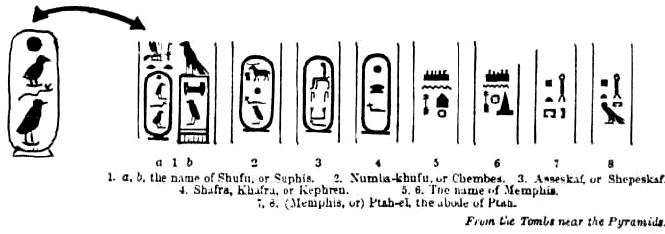
Fig. 149
Wilkinson's new presentation must have shocked
Vyse and Hill,
because he appeared to have changed his mind regarding the ram
cartouche (No. 2 in his Plate). He now read it "Numba-khufu or
Chembes" rather than "Sen-Suphis." These names, he wrote, were found
inscribed in tombs in the vicinity of the Great Pyramid; and it was
in cartouche la that "we perceive Suphis, or, as the hieroglyphics
wrote it, Shufu or Khufu, a name easily converted into Suphis or
Cheops." So that was the correct name that had to be inscribed!
For whom, then, did the ram cartouche (his fig. 2) stand? Explaining
the difficulties of identification, Wilkinson admitted that he could
not decide "whether the first two names here introduced are both of Suphis, or if the second one is of the founder of the other
pyramid."
With this unsettling news, what were Vyse and Hill to do?
Wilkinson's narrative gave them a lead, which they hurried to
follow. The two names, he wrote on, "occur again at Mount Sinai."
Somewhat inaccurately—a fault common in his work—Wilkinson was
referring to hieroglyphic inscriptions found not actually at Mount
Sinai, but in the Sinai's area of the turquoise mines. The
inscriptions became known in those years due to the magnificently
illustrated Voyage de l'Arabie Petrie in which Leon de Laborde et
Linat described the Sinai peninsula.
Published in 1832, its drawings
included reproductions of monuments and inscriptions in the wadi
leading to the mining area, Wadi Maghara. There, Pharaoh after
Pharaoh carved on the rocks mementoes of their achievements in
holding the mines against marauding Asiatics. One such depiction
(Fig. 150) included the two cartouches of which Wilkinson wrote.
Vyse and Hill should have had little difficulty in locating a copy
of de Laborde's Voyage in French-speaking Cairo. The particular
drawing seemed to answer Wilkinson's doubt: the same Pharaoh
appeared to have two names, one with the ram symbol and the other
that spelt out Kh-u-f-u. Thus, by May 9, Vyse-Hill-Perring had
learned that one more cartouche was needed, and what it had to look
like.
When Campbell's Chamber was broken into on May 27, the three must
have asked themselves: what are we waiting for? And so it was that
the final conclusive cartouche appeared on the uppermost wall (Fig.
146a). Fame, if not fortune, was assured for Vyse; Mr. Hill, on his
part, did not come out of the adventure empty-handed.
How sure can we be of our accusations, a century and a half
after the event?
Sure enough. For, as most forgers, Mr. Hill made, on top of all the
other embarrassments, one grave mistake: a mistake that no ancient
scribe could have possibly committed.
As it turned out, both source books by which Vyse-Hill were guided
(Wilkinson's Materia Hieroglyphica and then de Laborde's Voyage)
contained spelling errors; the unsuspecting team embodied the
errors in the pyramid's inscriptions.
Samuel Birch himself pointed out in his report that the hieroglyph
for Kh
(the first consonant in the name Kh-u-f-u), which is
 (representing
pictorially a sieve), "appears in Mr. Wilkinson's work without
distinction from the solar disk." The Kh hieroglyph had to be
employed in all the cartouches (spelling Khnem-Kh-u-f) which were
inscribed in the two lower chambers. But the correct sieve symbol
was not employed even once. Instead, the consonant Kh was
represented by the symbol for the Solar Disk: whoever inscribed
these cartouches made the same error as Wilkinson had made... .
(representing
pictorially a sieve), "appears in Mr. Wilkinson's work without
distinction from the solar disk." The Kh hieroglyph had to be
employed in all the cartouches (spelling Khnem-Kh-u-f) which were
inscribed in the two lower chambers. But the correct sieve symbol
was not employed even once. Instead, the consonant Kh was
represented by the symbol for the Solar Disk: whoever inscribed
these cartouches made the same error as Wilkinson had made... .
When Vyse and Hill got hold of de Laborde's book, its sketch only
deepened the error. The rock carvings depicted by him included the
cartouche Kh-u-f-u on the right, and Khnum-kh-u-f on the left. In
both instances, de Laborde—who admitted to ignorance of
hieroglyphics and who made no attempt to read the symbols—rendered
the Kh sign as a void
circle
 (see Fig. 150). (see Fig. 150).
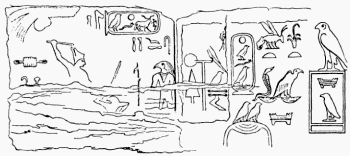
Fig. 150
(The Kh symbol was correctly
spelled
 in the rock carvings, as has been verified by all scholarly
authorities—viz. Lepsius in Denkmaler, Kurt Sethe in Urkunden des
Alten Reich, and The Inscriptions of Sinai by A. H. Gardiner and T.
E, Peet. De Laborde made another fateful error: He depicted as one
Pharaoh's inscription, with two royal names, what were in effect two
adjoining inscriptions, in different script styles, by two different
Pharaohs—as is clearly seen in Fig. 151). in the rock carvings, as has been verified by all scholarly
authorities—viz. Lepsius in Denkmaler, Kurt Sethe in Urkunden des
Alten Reich, and The Inscriptions of Sinai by A. H. Gardiner and T.
E, Peet. De Laborde made another fateful error: He depicted as one
Pharaoh's inscription, with two royal names, what were in effect two
adjoining inscriptions, in different script styles, by two different
Pharaohs—as is clearly seen in Fig. 151).
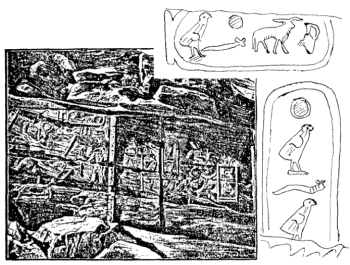
Fig. 151
His depiction thus served to enhance Vyse's and Hill's notion that
the crucial cartouche of Kh-u-f-u should be inscribed in the
uppermost chamber with the symbol for the Solar Disk (146a). But in
doing so, the inscriber had employed the hieroglyphic symbol and
phonetic sound for RA, the supreme God of Egypt! He had unwittingly
spelled out not Khnem-Khuf, but Khnem-Rauf; not Khufu, but Raufu. He
had used the name of the great God incorrectly and in vain; it was
blasphemy in ancient Egypt.
It was also an error inconceivable for an Egyptian scribe of the
times of the Pharaohs. As monument after monument and inscription
after inscription make clear, the symbol for Ra
 and the symbol for Kh and the symbol for Kh
 were always correctly employed—not only in different inscrip-tions,
but also in the same inscription by the same scribe.
were always correctly employed—not only in different inscrip-tions,
but also in the same inscription by the same scribe.
And, therefore, the substitution of Ra for Kh was an error that
could not have been committed in the time of Khufu, nor of any other
ancient Pharaoh. Only a stranger to hieroglyphics, a stranger to
Khufu, and a stranger to the overpowering worship of Ra, could have
committed such a grave error.
Added to all the other puzzling or inexplicable aspects of the
discovery reported by Vyse, this final mistake establishes
conclusively, we believe, that Vyse and his aides, not the original
builders of the Great Pyramid, caused the red-painted markings to be
inscribed.
But, one may ask, was there no risk that outside visitors—such as
the British and Austrian consuls, or Lord and Lady Arbuthnot—would
notice that the inscriptions were so much fresher-looking than the
masons' true markings? The question was answered at the time by one
of the men involved, Mr. Perring, in his own volume on the subject
(The Pyramids of Gizeh).
The paint used for the ancient
inscriptions, he wrote, was a "composition of red ochre called by
the Arabs moghrah (which) is still in use." Not only was the same
red ochre paint available, Perring stated, but "such is the state of
preservation of the marks in the quarries, that it is difficult to distinguish the mark of yesterday from one of
three thousand years."
The forgers, in other words, were sure of their ink.
Were Vyse and Hill—possibly with the tacit connivance of Perring—
morally capable of perpetrating such a forgery?
The circumstances of Vyse launching into this adventure of
discovery, his treatment of Caviglia, the chronology of events, his
determination to obtain a major find as time and money were running
out—bespeak a character capable of such a deed. As to Mr. Hill—whom
Vyse endlessly thanks in his foreword—the fact is that having been a
copper mill employee when he first met Vyse, he ended up owning the
Cairo Hotel when Vyse left Egypt. And as to Mr. Perring, a civil
engineer turned Egyptologist—well, let subse-quent events speak for
themselves. For, encouraged by the success of one forgery, the Vyse
team attempted one and probably two more... .
All along, as the discoveries were being made in the Great Pyramid,
Vyse half-heartedly continued Caviglia's work in and around the
other two pyramids. Encouraged by his newly won fame by the Great
Pyramid discoveries, Vyse decided to postpone his return to England
and instead engage in concerted efforts to uncover the secrets of
the other two pyramids.
With the exception of red-painted markings on stones, which experts
from Cairo determined were from tombs or structures outside the
pyramids and not from within the pyramids, nothing of importance was
found in the Second Pyramid. But inside the Third Pyramid, Vyse's
efforts paid off. At the end of July, 1837—as we have briefly
mentioned earlier—his workmen broke into its "sepulchral chamber,"
finding there a beautifully decorated but empty stone "sarcophagus"
(Fig. 152).
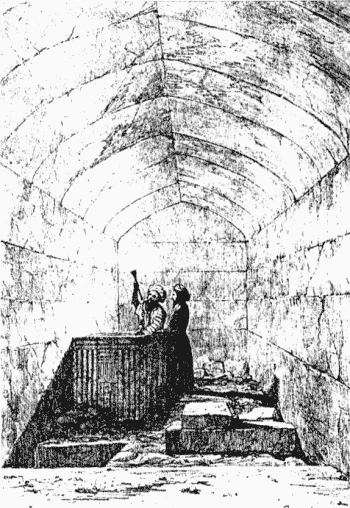
Fig. 152
Arabic inscriptions on the walls and other evidence
suggested this pyramid "to have been much frequented," the floor
stones of its chambers and passages "worn and glazed over by the
constant passing and repassing of a concourse of people."
Yet in this much frequented pyramid, and in spite of the empty stone
coffer, Vyse managed to find proof of its builder—a feat equaling
the discovery within the Great Pyramid.
In another rectangular chamber which Vyse called "the large
apartment." great piles of rubbish were found, along with the
telltale scrawled Arabic-graffiti. Vyse at once concluded that this
chamber "was probably intended for funeral ceremonies, like those at
Abou Simbel, Thebes, etc."
When the rubbish was cleared out,
the greater part of the lid of the sarcophagus was found ... and
close to it, fragments of the top of a mummy-case (inscribed with
hieroglyphics, and amongst them, with the cartouche of Menkahre)
were discovered upon a block of stone, together with part of a
skeleton,
consisting of ribs and vertebrae, and the bones of the legs and feet
enveloped in coarse woollen cloth of a yellow color ...
More of the board and cloth were afterwards taken out of the
rubbish.
It would therefore seem that, as the sarcophagus could not be
removed, the wooden case containing the body had been brought into
the large apartment for examination.
This, then, was the scenario outlined by Vyse: Centuries earlier,
Arabs had broken in the sepulchral chamber. They found the
sarcophagus and removed its lid. Inside there was a mummy within a
wooden coffin—the mummy of the pyramid's builder. The Arabs removed
coffin and mummy to the large apartment to examine them, breaking
them in the process. Now Vyse found all these remains; and a
cartouche on a fragment of the mummy-case (Fig. 153) spelled out
"Men-ka-ra"—the very Mycerinus of Herodotus. He proved the identity
of the builders of both pyramids!
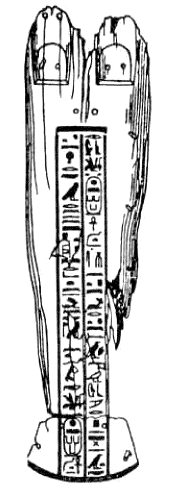
Fig. 153
The sarcophagus was lost at sea during its transportation to
England. But the mummy-case and bones reached safely the British
Museum, where Samuel Birch could examine the actual inscription,
rather than work from facsimiles (as was the case of the
inscriptions within the chambers in the Great Pyramid). He soon
voiced his doubts: "the coffin of Mycerinus," he said, "manifests
considerable difference of style" from monuments of the Fourth
Dynasty. Wilkinson, on the other hand, accepted the mummy-case as
authentic proof of the identity of the builder of the Third Pyramid;
but had doubts regarding the mummy itself: its cloth wrappings
did not look to him as being of the claimed antiquity.
In 1883,
Gaston Maspero concurred "that the wooden coffer-cover of king
Menchere is not of the Fourth Dynasty times;" he deemed it a
restoration carried out in the Twenty-Fifth Dynasty. In 1892, Kurt Sethe summed up the majority opinion, that the coffin-cover "could
have been fashioned only after Twentieth Dynasty times."
As is now well known, both mummy-case and bones were not the remains
of an original burial. In the words of I.E.S. Edwards (The Pyramids
of Egypt),
"In the original burial chamber, Col. Vyse had discovered
some human bones and the lid of a wooden anthropoid coffin inscribed
with the name of Mycerinus. This lid, which is now in the British
Museum, cannot have been made in the time of Mycerinus, for it is of
a pattern not used before the Saite Period. Radiocarbon tests have
shown that the bones date from early Christian times."
The mere statement negating the authenticity of the find does not,
however, go to the core of the matter. If the remains were not of an
original burial, then they must have been of an intrusive burial;
but in such a case, mummy and coffin would be of the same period.
This was not the case: here, someone had put together a mummy
unearthed in one place, a coffin from another place. The unavoidable
conclusion is that the find represented a deliberate archaeological
fraud.
Could the mismatching have been a coincidence—the genuine remains
within the pyramid of two intrusive burials, from different times?
This must be doubted, in view of the fact that the coffin fragment
bore the cartouche of Men-ka-ra. This cartouche has been found on
statues and in inscriptions all around the Third Pyramid and its
temples (but not inside it), and it is probable that the coffin
bearing the cartouche was also found in those surroundings.
The
coffin's attribution to later times stems not only from its-pattern,
but also from the wording of the inscription: it is a prayer to
Osiris from the Book of the Dead; its appearance on a Fourth Dynasty
coffin has been termed remarkable even by the trusting (yet
knowledgeable) Samuel Birch (Ancient History from the Monuments).
Yet it need not have been "a restoration," as some scholars have
suggested, from the Twenty-sixth Dynasty. We know from the King List
of Seti I from Abydos that the eighth Pharaoh of the Sixth Dynasty
was also called Men-ka-ra, and spelled his name in a similar manner.
It is clear, then, that someone had first found, in the vicinity of
the pyramid, the coffin. Its importance was surely realized, for—as
Vyse himself has reported—he had found just a month previously the
name of Men-ka-ra (Mycerinus) written in red paint on the roof of
the burial chamber of the middle one of the three small pyramids,
south of the Third Pyramid. It must have been this find that gave
the team the idea of creating a discovery within the Third Pyramid
itself... .
The credit for the discovery has been claimed by Vyse and Perring.
How could they have perpetrated the fraud, with or without the help
of Mr. Hill?
Once again, Vyse s own chronicles hint at the truth.
"Not being
present when they (the relics) were found," Col. Vyse wrote, he
"requested Mr. Raven, when that gentleman was in England, to write
an account of the discovery" as an independent witness.
Somehow
invited to be present at the right moment, Mr. H. Raven, who
addressed Col. Vyse as "Sir" and signed the Letter of Evidence "your
most obedient servant," attested as follows:
In clearing the rubbish out of the large entrance-room, after the
men
had been employed there several days and had advanced some distance
towards the south-eastern corner, some bones were first discovered
at
the bottom of the rubbish; and the remaining bones and parts of the
coffin
were immediately discovered altogether: no other parts of the coffin
or
bones could be found in the room.
I therefore had the rubbish, which had been previously turned out of
the same room, carefully re-examined, when several pieces of the
coffin
and of the mummy-cloth were found; but
In no other part of the pyramid were any parts of it to be
discovered,
although every place was most minutely examined to make the coffin
as
complete as possible.
We now get a better grasp of what had happened. For several days,
workmen were clearing rubbish from the Large Apartment, piling it up
nearby. Though carefully examined, nothing was found. Then, on the
last day, as only the southeastern corner of the room remained to be
cleared, some bones and fragments of a wooden coffin were
discovered. "No other parts of the coffin or bones could be
discovered in the room."
It was then wisely suggested that the
rubbish which had been turned out of the room— a three-foot-high
pile—be "carefully re-examined"—not examined, but RE-examined;
and—lo and behold—more bones, and coffin fragments with the
all-important cartouche, were found!
Where were the remaining parts of the skeleton and coffin? "Although
every place was minutely examined to make the coffin as complete as
possible," nothing was found in any other part of the pyramid. So,
unless we are to believe that bones and coffin fragments were hauled
away as souvenirs in centuries past, we can only assume that whoever
hauled in the discovered parts, brought in just enough fragments to
create the discovery: a complete coffin and a complete mummy were
either unavailable, or too cumbersome to be smuggled in.
Hailed for this second major discovery—he was soon thereafter
promoted to the rank of general—Col. Vyse and Perring proceeded to
produce at the site of Zoser's step pyramid a stone bearing Zoser's
name—written in red paint, of course. There is not enough detail in
the chronicles to ascertain
whether or not that too was a forgery; but it is indeed incredible
that it was again the same team who managed to unearth proof of yet
one more pyramid builder.
(While most Egyptologists have accepted without further
investigation the claim that Khufu's name was inscribed in the Great
Pyramid, the works of Sir Alan Gardiner suggest that he had doubts
on the subject. In his Egypt of the Pharaohs, he reproduced royal
cartouches with a clear distinction between the hieroglyphs for Ra
and Kh. The cartouche of Cheops, he wrote, "is found in various
quarries, in the tombs of his kinfolk and nobles, and in certain
writing of later date." Conspicuous by its absence in this list is
the inscription in the Great Pyramid ... Also omitted by Sir Alan
were any mention of Vyse's discoveries in the Third Pyramid and even
of Vyse's name as such).
If the proof of the construction of the Giza pyramids by the
presumed Pharaohs stands shattered, there is no longer reason to
suspect the authenticity of the Inventory Stela, which stated that
the pyramids and the Sphinx were already there when Khufu came to
pay homage to Isis and Osiris.
There is nothing left to contradict our contention that these three
pyramids were built by the "Gods." On the contrary: everything about
them suggests that they were not conceived by men for men's use.
We shall now proceed to show how they were part of the Guidance Grid
that served the Spaceport of the Nefilim.
Back to
Contents
|










 or as a void sphere
or as a void sphere
 , and in linear
(or brushed-on) writing as a circle with a dot in its center
, and in linear
(or brushed-on) writing as a circle with a dot in its center
 .
. 

 (representing
pictorially a sieve), "appears in Mr. Wilkinson's work without
distinction from the solar disk." The Kh hieroglyph had to be
employed in all the cartouches (spelling Khnem-Kh-u-f) which were
inscribed in the two lower chambers. But the correct sieve symbol
was not employed even once. Instead, the consonant Kh was
represented by the symbol for the Solar Disk: whoever inscribed
these cartouches made the same error as Wilkinson had made... .
(representing
pictorially a sieve), "appears in Mr. Wilkinson's work without
distinction from the solar disk." The Kh hieroglyph had to be
employed in all the cartouches (spelling Khnem-Kh-u-f) which were
inscribed in the two lower chambers. But the correct sieve symbol
was not employed even once. Instead, the consonant Kh was
represented by the symbol for the Solar Disk: whoever inscribed
these cartouches made the same error as Wilkinson had made... .
 (see Fig. 150).
(see Fig. 150). 
 in the rock carvings, as has been verified by all scholarly
authorities—viz. Lepsius in Denkmaler, Kurt Sethe in Urkunden des
Alten Reich, and The Inscriptions of Sinai by A. H. Gardiner and T.
E, Peet. De Laborde made another fateful error: He depicted as one
Pharaoh's inscription, with two royal names, what were in effect two
adjoining inscriptions, in different script styles, by two different
Pharaohs—as is clearly seen in Fig. 151).
in the rock carvings, as has been verified by all scholarly
authorities—viz. Lepsius in Denkmaler, Kurt Sethe in Urkunden des
Alten Reich, and The Inscriptions of Sinai by A. H. Gardiner and T.
E, Peet. De Laborde made another fateful error: He depicted as one
Pharaoh's inscription, with two royal names, what were in effect two
adjoining inscriptions, in different script styles, by two different
Pharaohs—as is clearly seen in Fig. 151). 
 and the symbol for Kh
and the symbol for Kh
 were always correctly employed—not only in different inscrip-tions,
but also in the same inscription by the same scribe.
were always correctly employed—not only in different inscrip-tions,
but also in the same inscription by the same scribe. 
